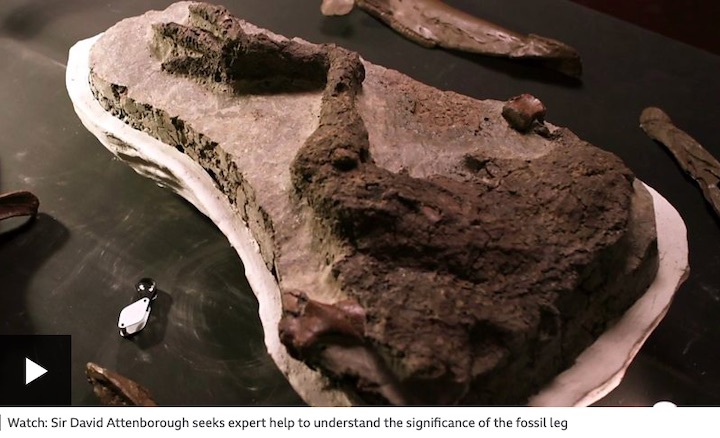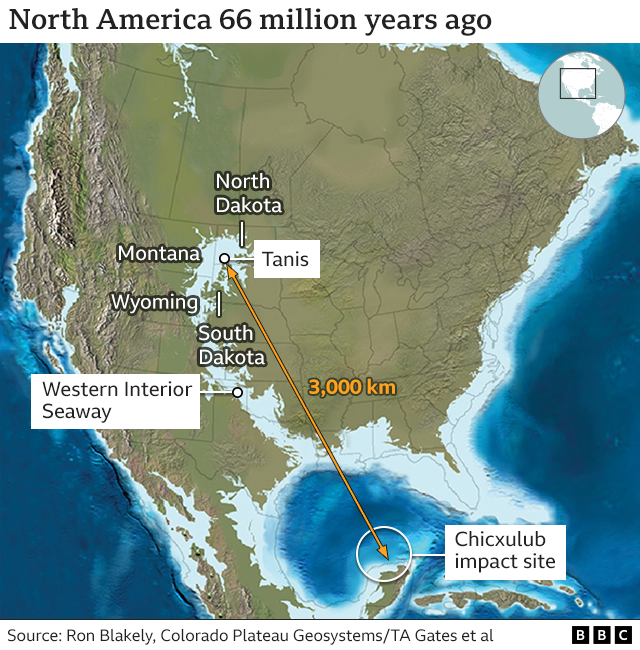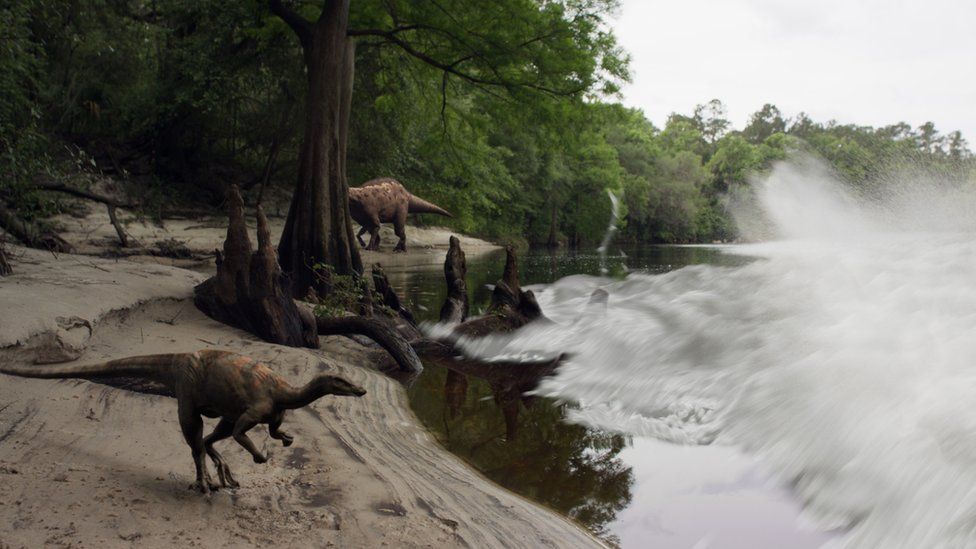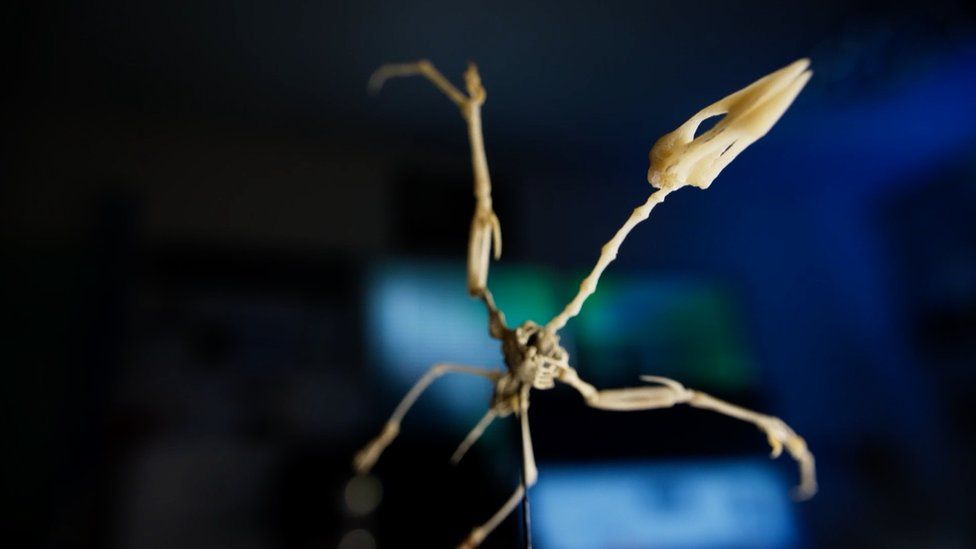8.04.2022

Scientists have presented a stunningly preserved leg of a dinosaur.
The limb, complete with skin, is just one of a series of remarkable finds emerging from the Tanis fossil site in the US State of North Dakota.
But it's not just their exquisite condition that's turning heads - it's what these ancient specimens purport to represent.
The claim is the Tanis creatures were killed and entombed on the actual day a giant asteroid struck Earth.
The day 66 million years ago when the reign of the dinosaurs ended and the rise of mammals began.
Very few dinosaur remains have been found in the rocks that record even the final few thousand years before the impact. To have a specimen from the cataclysm itself would be extraordinary.
The BBC has spent three years filming at Tanis for a show to be broadcast on 15 April, narrated by Sir David Attenborough.
Sir David will review the discoveries, many that will be getting their first public viewing.
Along with that leg, there are fish that breathed in impact debris as it rained down from the sky.
We see a fossil turtle that was skewered by a wooden stake; the remains of small mammals and the burrows they made; skin from a horned triceratops; the embryo of a flying pterosaur inside its egg; and what appears to be a fragment from the asteroid impactor itself.
"We've got so many details with this site that tell us what happened moment by moment, it's almost like watching it play out in the movies. You look at the rock column, you look at the fossils there, and it brings you back to that day," says Robert DePalma, the University of Manchester, UK, graduate student who leads the Tanis dig.
It's now widely accepted that a roughly 12km-wide space rock hit our planet to cause the last mass extinction.
The impact site has been identified in the Gulf of Mexico, off the Yucatan Peninsula. That's some 3,000km away from Tanis, but such was the energy imparted in the event, its devastation was felt far and wide.
The North Dakota fossil site is a chaotic jumble.
The remains of animals and plants seem to have been rolled together into a sediment dump by waves of river water set in train by unimaginable earth tremors. Aquatic organisms are mixed in with the land-based creatures.

The sturgeon and paddlefish in this fossil tangle are key. They have small particles stuck in their gills. These are the spherules of molten rock kicked out from the impact that then fell back across the planet. The fish would have breathed in the particles as they entered the river.
The spherules have been linked chemically and by radiometric dating to the Mexican impact location, and in two of the particles recovered from preserved tree resin there are also tiny inclusions that imply an extra-terrestrial origin.
"When we noticed there were inclusions within these little glass spherules, we chemically analysed them at the Diamond X-ray synchrotron near Oxford," explains Prof Phil Manning, who is Mr DePalma's PhD supervisor at Manchester.
"We were able to pull apart the chemistry and identify the composition of that material. All the evidence, all of the chemical data, from that study suggests strongly that we're looking at a piece of the impactor; of the asteroid that ended it for the dinosaurs."
The existence of Tanis, and the claims made for it, first emerged in the public sphere in the New Yorker Magazine in 2019. This caused a furore at the time.
Science usually demands the initial presentation of new discoveries is made in the pages of a scholarly journal. A few peer-reviewed papers have now been published, and the dig team promises many more as it works through the meticulous process of extracting, preparing and describing the fossils.
To make its TV programme, the BBC called in outside consultants to examine a number of the finds.
Prof Paul Barrett from London's Natural History Museum looked at the leg. He's an expert in ornithischian (mostly plant-eating) dinosaurs.
"It's a Thescelosaurus. It's from a group that we didn't have any previous record of what its skin looked like, and it shows very conclusively that these animals were very scaly like lizards. They weren't feathered like their meat-eating contemporaries.
"This looks like an animal whose leg has simply been ripped off really quickly. There's no evidence on the leg of disease, there are no obvious pathologies, there's no trace of the leg being scavenged, such as bite marks or bits of it that are missing," he tells me.
"So, the best idea that we have is that this is an animal that died more or less instantaneously."

The big question is whether this dinosaur did actually die on the day the asteroid struck, as a direct result of the ensuing cataclysm. The Tanis team thinks it very likely did, given the limb's position in the dig sediments.
If that is the case, it would be quite the discovery.
But Prof Steve Brusatte from University of Edinburgh says he's sceptical - for the time being.
He's acted as another of the BBC's outside consultants. He wants to see the arguments presented in more peer-reviewed articles, and for some palaeo-scientists with very specific specialisms to go into the site to give their independent assessment.
Prof Brusatte says it's possible, for example, that animals that had died before the impact were exhumed by the violence on the day and then re-interred in a way that made their deaths appear concurrent.
"Those fish with the spherules in their gills, they're an absolute calling card for the asteroid. But for some of the other claims - I'd say they have a lot circumstantial evidence that hasn't yet been presented to the jury," he says.
"For some of these discoveries, though, does it even matter if they died on the day or years before? The pterosaur egg with a pterosaur baby inside is super-rare; there's nothing else like it from North America. It doesn't all have to be about the asteroid."


There's no doubting the pterosaur egg is special.
With modern X-ray technology it's possible to determine the chemistry and properties of the egg shell. It was likely leathery rather than hard, which may indicate the pterosaur mother buried the egg in sand or sediment like a turtle.
It's also possible with X-ray tomography to extract virtually the bones of the pterosaur chick inside, to print them and reconstruct what the animal would have looked like. Mr DePalma has done this.
The baby pterosaur was probably a type of azhdarchid, a group of flying reptiles whose adult wings could reach more than 10m from tip to tip.
Mr DePalma gave a special lecture on the Tanis discoveries to an audience at the US space agency Nasa's Goddard Space Flight Center on Wednesday. Heand Prof Manning will also present their latest data to the European Geosciences Union General Assembly in May.
Dinosaurs: The Final Day with Sir David Attenborough will be broadcast on BBC One on 15 April at 18:30 BST. A version has been made for the US science series Nova on the PBS network to be broadcast later in the year.
Quelle: BBC
